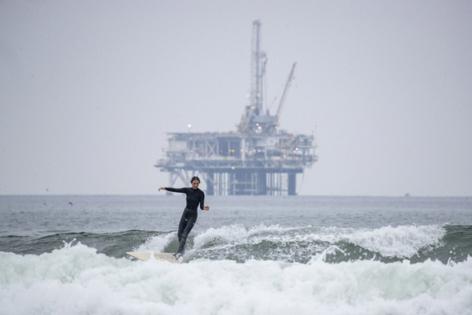Lawmakers give a thumbs down on expanding offshore drilling in California
Published in Science & Technology News
SAN DIEGO — A bipartisan group of lawmakers on the state and federal levels spoke out Tuesday against plans by the Trump administration for new offshore drilling in the Golden State, including parcels in Southern California and San Diego.
“There’s very little support for drilling on our coastline,” California Assembly member Laurie Davies, R-Laguna Niguel, said at a news conference in Solana Beach. “If we need to support or reject offshore oil drilling in the 74th Assembly District (in Orange County), it’s not gonna to be just no, it’s gonna be hell no.”
Rep. Mike Levin, D-San Juan Capistrano, called on his colleagues in Congress to pass legislation he has introduced that would prevent new leasing for the exploration, development, or production of oil or natural gas in federal waters along the Southern California coast, from San Diego to the northern border of San Luis Obispo County.
“We’re going to continue to fight this legislatively and legally, and from a communications perspective and any other tools that we’ve got in the toolkit,” Levin said.
Last week, the U.S. Department of the Interior announced a five-year plan that included proposals for six offshore leases in federal waters off the coast of California. The southern-most potential lease site would extend from San Diego to San Luis Obispo.
If enacted, the move would mark the first new oil and gas leases in federal waters off the coast of California since 1984.
The draft map also includes expanding offshore drilling in Alaska and along the eastern portion of the Gulf of Mexico, renamed the Gulf of America by President Donald Trump via executive order earlier this year.
Before any lease sales are finalized, the Department of the Interior will host a 60-day comment period in which members of the public can make their voices heard.
There are already 23 oil and gas production facilities in federal waters off the coast of California, according to the State Lands Commission, although some of them are no longer profitable to maintain. Twenty-two of those produce oil and gas, while the other is a processing facility.
In state waters, there are three offshore oil platforms — one off of Santa Barbara County and two in the Huntington Beach area. Earlier this year, a facility called Platform Esther off Seal Beach was decommissioned by the Lands Commission.
There’s also a set of artificial islands that produce oil, including the THUMS Islands in San Pedro Bay near Long Beach.
According to a November 2021 report from the California Energy Commission, offshore production from facilities in federal waters equated to just 1% of all crude oil processed in California refineries. Within state waters, the report said offshore facilities accounted for about 6% of total California production from 2011 through 2020.
Interior Secretary Doug Burgum signed the proposal to expand offshore drilling last week as part of the Trump administration’s larger efforts for “unleashing American energy.”
“The Biden administration slammed the brakes on offshore oil and gas leasing and crippled the long-term pipeline of America’s offshore production,” Burgum said in a statement. “By moving forward with the development of a robust, forward-thinking leasing plan, we are ensuring that America’s offshore industry stays strong, our workers stay employed and our nation remains energy dominant for decades to come.”
Californians pay the highest average price for a gallon of gasoline in the country. According to AAA, the average price in San Diego on Tuesday stood at $4.787, compared to the national average of $3.055.
“We all want to see energy costs come down but this is not the way to do that,” Levin said. “The amount of harm that this could do for the de minimis amount of new oil that you would produce, even under the best estimates from the fossil fuel industry … (is) simply not worth it.”
Levin’s bill, HR 2862, is called the Southern California Coast and Ocean Protection Act. Brought forth in April, it’s awaiting a hearing in the House Natural Resources Committee.
Levin introduced the bill along with seven other Democrats that seeks limits in states such as North Carolina, Florida, Rhode Island, New Jersey, as well as legislation that would extend drilling bans along the entire coast of California.
Davies pointed to Senate Bill 237 — recently passed by the California Legislature — as a way to give California drivers some relief at the pump. It included provisions aimed at increasing crude oil production in the state and eased permitting requirements in Kern County, the heart of the state’s Oil Patch.
“The federal government should take notice of this achievement before expanding drilling on our coastlines,” she said.
In addition to Davies and Levin, Tuesday’s news conference included comments from state Sen. Catherine Blakespear, Assembly member Tasha Boerner and Lisa Gilfillan, California field representative for the environmental group Oceana.
©2025 The San Diego Union-Tribune. Visit sandiegouniontribune.com. Distributed by Tribune Content Agency, LLC.







Comments